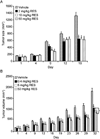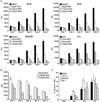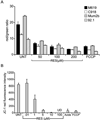Resveratrol inhibits uveal melanoma tumor growth via early mitochondrial dysfunction
- PMID: 18385041
- PMCID: PMC2465765
- DOI: 10.1167/iovs.07-1233
Resveratrol inhibits uveal melanoma tumor growth via early mitochondrial dysfunction
Abstract
Purpose: To test the efficacy of resveratrol, a nontoxic plant product, in the treatment of uveal melanoma.
Methods: The effect of oral administration and peritumor injection of resveratrol was tested on tumor growth in two animal models of uveal melanoma. The mechanism of resveratrol action on uveal melanoma cells was studied in vitro in a cell-viability assay: with JC-1 dye, to measure mitochondrial membrane potential; by Western blot analysis, to analyze the cellular redistribution of cytochrome c and Smac/diablo; and in a fluorescence assay with specific substrates, to measure activation of different caspases.
Results: Resveratrol treatment inhibited tumor growth in animal models of uveal melanoma. Since oral administration resulted in relatively low bioavailability of resveratrol, the effect of increased local levels was tested by peritumor injection of the drug. This method resulted in tumor cell death and tumor regression. In vitro experiments with multiple uveal melanoma cell lines demonstrate that resveratrol causes a decrease in cell viability, resulting at least in part from an increase in apoptosis through a mitochondrial pathway. An early event in drug action is the direct targeting of mitochondria by resveratrol, which leads to a decrease in mitochondrial membrane potential and the eventual activation of caspase-3.
Conclusion: These data suggest that resveratrol can inhibit tumor growth and can induce apoptosis via the intrinsic mitochondrial pathway and that by further increasing bioavailability of resveratrol the potency of the drug can be increased, leading to tumor regression. The nontoxic nature of the drug at levels needed for therapy make resveratrol an attractive candidate for the treatment of uveal melanoma.
Figures





Similar articles
-
Authenticating cell lines in ophthalmic research laboratories.Invest Ophthalmol Vis Sci. 2008 Nov;49(11):4697-701. doi: 10.1167/iovs.08-2324. Epub 2008 Aug 8. Invest Ophthalmol Vis Sci. 2008. PMID: 18689700 Free PMC article. Review. No abstract available.
-
Butein induces apoptosis in human uveal melanoma cells through mitochondrial apoptosis pathway.Curr Eye Res. 2012 Aug;37(8):730-9. doi: 10.3109/02713683.2012.671436. Epub 2012 May 11. Curr Eye Res. 2012. PMID: 22578288
-
Resveratrol inhibits tumor growth of human neuroblastoma and mediates apoptosis by directly targeting mitochondria.Clin Cancer Res. 2007 Sep 1;13(17):5162-9. doi: 10.1158/1078-0432.CCR-07-0347. Clin Cancer Res. 2007. PMID: 17785572
-
Resveratrol induces apoptosis associated with mitochondrial dysfunction in bladder carcinoma cells.Int J Urol. 2012 Aug;19(8):757-64. doi: 10.1111/j.1442-2042.2012.03024.x. Epub 2012 May 21. Int J Urol. 2012. PMID: 22607368
-
Resveratrol in the management of human cancer: how strong is the clinical evidence?Ann N Y Acad Sci. 2013 Jul;1290:12-20. doi: 10.1111/nyas.12205. Ann N Y Acad Sci. 2013. PMID: 23855461 Review.
Cited by
-
Resveratrol and Ophthalmic Diseases.Nutrients. 2016 Apr 5;8(4):200. doi: 10.3390/nu8040200. Nutrients. 2016. PMID: 27058553 Free PMC article. Review.
-
Autophagy and mitochondrial dysfunction in adjuvant-arthritis rats treatment with resveratrol.Sci Rep. 2016 Sep 9;6:32928. doi: 10.1038/srep32928. Sci Rep. 2016. PMID: 27611176 Free PMC article.
-
Tissue Distribution of trans-Resveratrol and Its Metabolites after Oral Administration in Human Eyes.J Ophthalmol. 2017;2017:4052094. doi: 10.1155/2017/4052094. Epub 2017 Mar 20. J Ophthalmol. 2017. PMID: 28409021 Free PMC article.
-
Authenticating cell lines in ophthalmic research laboratories.Invest Ophthalmol Vis Sci. 2008 Nov;49(11):4697-701. doi: 10.1167/iovs.08-2324. Epub 2008 Aug 8. Invest Ophthalmol Vis Sci. 2008. PMID: 18689700 Free PMC article. Review. No abstract available.
-
The grape antioxidant resveratrol for skin disorders: promise, prospects, and challenges.Arch Biochem Biophys. 2011 Apr 15;508(2):164-70. doi: 10.1016/j.abb.2010.12.030. Epub 2011 Jan 4. Arch Biochem Biophys. 2011. PMID: 21215251 Free PMC article. Review.
References
-
- Collaborative Ocular Melanoma Study Group Assessment of metastatic disease status at death in 435 patients with large choroidal melanoma in the collaborative ocular melanoma study (COMS): COMS report no. 15. Arch Ophthalmol. 2001;119(5):670–676. - PubMed
-
- Pach JM, Robertson DM. Metastasis from untreated uveal melanomas. Arch Ophthalmol. 1986;104:1624–1625. - PubMed
-
- Wagoner MD, Albert DM. The incidence of metastases from untreated ciliary body and choroidal melanoma. Arch Ophthalmol. 1982;100:939–940. - PubMed
-
- Wang MX, Shields JA, Donoso LA. Subclinical metastasis of uveal melanoma. Int Ophthalmol Clin. 1993;33:119–127. - PubMed
-
- Shields JA, Augsburger JJ, Donoso LA, Bernardino VB, Jr, Portenar M. Hepatic metastasis and orbital recurrence of uveal melanoma after 42 years. Am J Ophthalmol. 1985;100:666–668. - PubMed
Publication types
MeSH terms
Substances
Grants and funding
LinkOut - more resources
Full Text Sources
Medical
Research Materials

